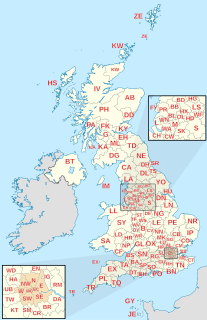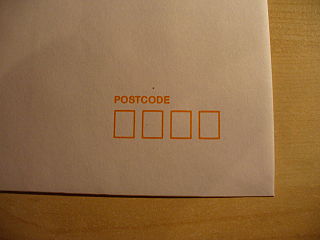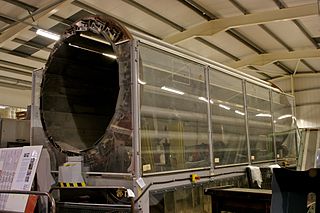A ZIP Code is a postal code used by the United States Postal Service (USPS) in a system it introduced in 1963. The term ZIP is an acronym for Zone Improvement Plan; it was chosen to suggest that the mail travels more efficiently and quickly when senders use the code in the postal address. The basic format consists of five digits. An extended ZIP+4 code was introduced in 1983 which includes the five digits of the ZIP Code, followed by a hyphen and four additional digits that reference a more specific location.

A barcode is a visual, machine-readable representation of data; the data usually describes something about the object that carries the barcode. Traditional barcodes systematically represent data by varying the widths and spacings of parallel lines, and may be referred to as linear or one-dimensional (1D). Later, two-dimensional (2D) variants were developed, using rectangles, dots, hexagons and other geometric patterns, called matrix codes or 2D barcodes, although they do not use bars as such. Initially, barcodes were only scanned by special optical scanners called barcode readers. Later application software became available for devices that could read images, such as smartphones with cameras.

Postal codes used in the United Kingdom are known as postcodes. They are alphanumeric and were adopted nationally between 11 October 1959 and 1974, having been devised by the General Post Office. A full postcode is known as a "postcode unit" and designates an area with a number of addresses or a single major delivery point.

A magnetic stripe card is a type of card capable of storing data by modifying the magnetism of tiny iron-based magnetic particles on a band of magnetic material on the card. The magnetic stripe, sometimes called swipe card or magstripe, is read by swiping past a magnetic reading head. Magnetic stripe cards are commonly used in credit cards, identity cards, and transportation tickets. They may also contain an RFID tag, a transponder device and/or a microchip mostly used for business premises access control or electronic payment.

Code 39 is a variable length, discrete barcode symbology.

A bar code reader is an electronic device that can read and output printed barcodes to a computer. Like a flatbed scanner, it consists of a light source, a lens and a light sensor translating for optical impulses into electrical signals.Additionally, nearly all barcode readers contain decoder circuitry analyzing the bar code's image data provided by the sensor and sending the barcode's content to the scanner's output port.

QR code is the trademark for a type of matrix barcode first designed in 1994 for the automotive industry in Japan. A barcode is a machine-readable optical label that contains information about the item to which it is attached. In practice, QR codes often contain data for a locator, identifier, or tracker that points to a website or application. A QR code uses four standardized encoding modes to store data efficiently; extensions may also be used.

PostBar, also known as CPC 4-State, is the black-ink barcode system used by Canada Post in its automated mail sorting and delivery operations. It is similar to other 4 State barcode systems used by Australia Post and the United Kingdom's Royal Mail, but uses an obscured structure and encoding system unique to Canada Post. This particular bar code system is used on "flats" and parcels.
Automatic identification and data capture (AIDC) refers to the methods of automatically identifying objects, collecting data about them, and entering them directly into computer systems, without human involvement. Technologies typically considered as part of AIDC include QR codes, bar codes, Radio Frequency Identification (RFID), biometrics, magnetic stripes, Optical character recognition (OCR), smart cards, and voice recognition. AIDC is also commonly referred to as “Automatic Identification”, “Auto-ID” and "Automatic Data Capture".
CPC Binary Barcode is Canada Post's proprietary symbology used in its automated mail sortation operations. This barcode is used on regular-size pieces of mail, especially mail sent using Canada Post's Lettermail service. This barcode is printed on the lower-right-hand corner of each faced envelope, using a unique ultraviolet-fluorescent ink.
A multiline optical-character reader, or MLOCR, is a type of mail sorting machine that uses optical character recognition (OCR) technology to determine how to route mail through the postal system.
The Postal Alpha Numeric Encoding Technique (PLANET) barcode was used by the United States Postal Service to identify and track pieces of mail during delivery - the Post Office's "CONFIRM" services. It was fully superseded by Intelligent Mail Barcode by January 28, 2013.

MSI is a barcode symbology developed by the MSI Data Corporation, based on the original Plessey Code symbology. It is a continuous symbology that is not self-checking. MSI is used primarily for inventory control, marking storage containers and shelves in warehouse environments.
Scantext was a professional code-driven digital typesetting system popular in the 1980s, rendered obsolete by the popularity of the personal computer and desktop publishing software. It was developed and built by Scangraphic, a division of Dr. Böger Duplomat Apparate GmbH & Co.KG, based in Wedel near Hamburg, Germany.

The Intelligent Mail Barcode is a 65-bar barcode for use on mail in the United States. The term "Intelligent Mail" refers to services offered by the United States Postal Service for domestic mail delivery. The IM barcode is intended to provide greater information and functionality than its predecessors POSTNET and PLANET. An Intelligent Mail barcode has also been referred to as a One Code Solution and a 4-State Customer Barcode, abbreviated 4CB, 4-CB or USPS4CB. The complete specification can be found in USPS Document USPS-B-3200. It effectively incorporates the routing ZIP code and tracking information included in previously used postal barcode standards.

Postcodes are used in Australia to more efficiently sort and route mail within the Australian postal system. Postcodes in Australia have four digits and are placed at the end of the Australian address. Postcodes were introduced in Australia in 1967 by the Postmaster-General's Department and are now managed by Australia Post, and are published in booklets available from post offices or online from the Australia Post website.

First used by postal services to expedite and automate mail processing, mail sorting systems are now also used by corporations and other mailers to presort mail prior to delivery in order to earn discounts on postage. In the United States, for example, presort discounts can reduce the cost of First-Class Mail from $0.42 to as low as $0.324. Many companies also use mail sorters to handle incoming mail such as checks, orders and correspondence.
Forms processing is a process by which one can capture information entered into data fields and convert it into an electronic format. This can be done manually or automatically, but the general process is that hard copy data is filled out by humans and then "captured" from their respective fields and entered into a database or other electronic format.











